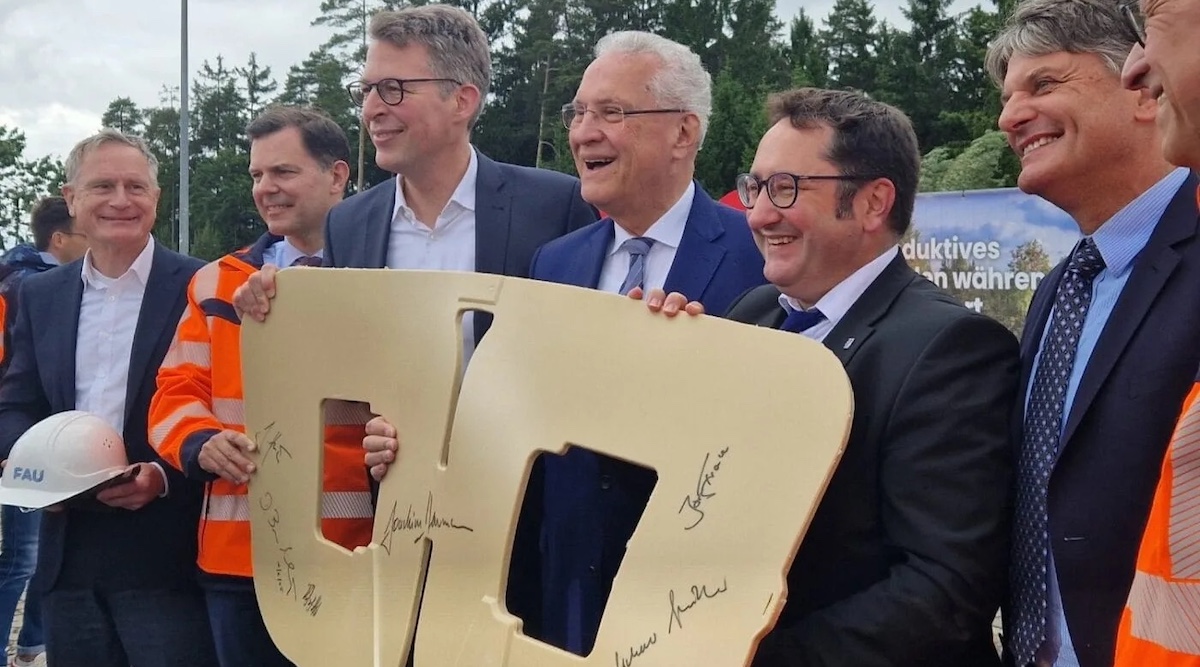Last Updated on: 16th June 2025, 10:38 am
There are a couple of ways to move heavy trucks and buses on electricity that do not involve massive batteries that are super expensive and diminish available cargo loads. One is to add a range extender engine or something like the ultra-efficient gas turbine pioneered by Wrightspeed. Another is to run wires overhead like trolleys have used in cities for generations, but that system is expensive to construct and maintain. A third way is to add inductive charging to the roadway and let those electric trucks and buses slurp up electrons while they drive.
That’s what Friedrich Alexander Universität Erlangen Nürnberg (FAU) is planning to do on a one-kilometer stretch of the A6 highway between Amberg–West and Sulzbach–Rosenberg in Bavaria in the second half of this year.
The E|MPOWER project is led by the chair of manufacturing, automation, and production systems at FAU in cooperation with the Federal Autobahb, VIA IMC, Electreon, Risomat, and Nuremberg Tech. The testing protocols later this year will assess the technical and economic integration of this solution for electrifying heavy goods transport.
At a ceremony celebrating the beginning of the inductive charging trial, Bavaria’s Minister of Science, Markus Blume, said: “We are quite literally paving the way for e-mobility. Until now, the road was the goal. From today, the road delivers the power, and that power comes from Bavaria! Inductive charging could be a genuine game-changer for electric mobility. With an efficiency rate of over 90 per cent, we are unlocking previously unthinkable possibilities. Range anxiety will become a thing of the past.”
FAU president Professor Joachim Hornegger added, “We are delighted to be part of this visionary project. Our thanks go to all partners for the excellent collaboration. Dynamic inductive charging of electric vehicles changes the way we think about mobility – for commuters, for travel, and in everyday life.”
The first charging trials using specially equipped vehicles are scheduled to take place in the second half of 2025. According to Professor Florian Risch, an expert in assembly technologies for electric energy storage, the project team is particularly interested in determining the system’s real-world efficiency and how inductive coils can be efficiently manufactured and automated for road integration, according to a report by Electrive.
“Thanks to this test route, we will gain crucial practical insights and scientifically grounded data to optimize both vehicle and infrastructure systems.” The necessary coils are currently being embedded in the road surface, with follow-up tests planned to verify the correct installation.
The electric road system was developed by the Israeli company Electreon, which relies on inductive coupling between copper coils installed beneath the road surface and a receiver unit fitted to a test vehicle. Conceptually, it is similar to wireless phone charging, in which power is transmitted through a magnetic field. The charging process is activated when a vehicle fitted with a receiver is parked above or passes over the coils embedded in the road surface.
The test route is part of the broader E|MPOWER research project launched in 2022, which is backed by Germany’s Federal Ministry for Economic Affairs and the Autobahn. The installation near Nuremberg is the first of its kind in Bavaria, although similar experimental programs have taken place in other German cities previously.
The test route in Bavaria involves a roadway that is longer than those other experimental induction charging projects in Germany, which also used equipment from Electreon. The focus of the A6 project is to demonstrate new construction techniques that will lead to reduced costs and installation times.
Electreon says, “Our wireless charging technology for both stationary applications and wireless electric road system is fast to deploy. We place our unique copper coils just below the surface of the road along highways, at bus stations, in parking lots, and at logistics centers. Deployment takes place at night to minimize disruption. The coils are then covered with asphalt and the Electric Road is ready to begin charging EVs.”
Here’s a video the company put together to explain how its system works:
At the end of last year, my colleague Tina Casey reported on inductive charging technology in the US. “The benefits of ditching the charging cable underscore yet another advantage of electric vehicles over gas-fueled conveyances,” she wrote. “Drivers save some time if they don’t have to fuss with a charging cable, and it’s an extra convenience in nasty weather or other inhibiting conditions. Then there’s the extra added convenience of in-road charging, which enables drivers to recharge while on the move.”
Inductive charging would be ideal for robotaxi services that do not have a human driver available to plug the cars in when their batteries need a boost, and yet we have never heard the people at Tesla mention the idea for their fleet of self-driving cars that are supposed to begin operating in Austin, Texas, soon.
This is an idea whose time has come. When range anxiety is holding many people back from switching to an electric car, this is a great way to address those fears. It’s also a great way to address emissions from heavy trucks in places like California that are burdened by diesel engine emissions.

Sign up for CleanTechnica’s Weekly Substack for Zach and Scott’s in-depth analyses and high level summaries, sign up for our daily newsletter, and follow us on Google News!
Whether you have solar power or not, please complete our latest solar power survey.
Have a tip for CleanTechnica? Want to advertise? Want to suggest a guest for our CleanTech Talk podcast? Contact us here.
Sign up for our daily newsletter for 15 new cleantech stories a day. Or sign up for our weekly one on top stories of the week if daily is too frequent.
CleanTechnica uses affiliate links. See our policy here.
CleanTechnica’s Comment Policy

